
Marine Life Microscopic Organisms Support Marine Food Webs


Marine Life Objectives:
- Provide examples of marine plankton and their roles in food webs.
- List examples of producer and consumer Protists.
- Describe the types of macroscopic producers found in marine habitats.
In the next two guides we are studying marine ecosystems with the course topic lenses: biodiversity, ecology, and conservation biology. Here are examples of a few of the concepts we’ll cover.
Biodiversity
-
Types of microscopic organisms that support marine food webs.
-
Adaptations tidal pool species have for surviving extreme conditions.
-
Examples of marine invertebrate phyla used in marine aquariums.
Ecology
-
The impact oceanic currents have on marine producers and food webs.
-
How “keystone species” like sea otters and sea stars have significant impacts on other species.
Conservation Biology
-
How minimizing potential threats and limited resources can improve the care of organisms.
-
Examining the prevalence and significance of plastics and other debris in beach sand.
We are also using skills that represent the different forms of science discovery: exploring, describing, and explaining.
Exploring
-
Examining different types of sands found on global beaches.
-
Searching for marine organisms in videos.
Describing
-
Listing the characteristics of protist marine producers.
-
Identifying marine invertebrates in an aquarium.
Explaining
-
Developing an organism care plan that minimizes threats and maximizes resources.
-
Telling a story about how increased carbon dioxide in the atmosphere can impact marine food webs.
And we are utilizing different forms of media to connect the story of marine ecosystems to real-world experiences.
Video

Photography

Text

This may look familiar; these are the different learning outcome categories (three concepts, three skills, and three connections) you will have represented in your final portfolio.
Your final portfolio will have 10 sections and be worth 20 points (20% of the course grade). Putting together the portfolio now can make the end of the term easier and ensure that each outcome is substantially represented with your personal work.
Introduction
You will be introduced to writing a introduction page in Module 10. Basically it is an overview to the portfolio format you have selected, including how your portfolio demonstrates achievement of course outcomes and how you may use the portfolio beyond this course.
Concepts
Three sections, each with a substantial body of work demonstrating understandings of:
Science Concepts
Biology Concepts
Environmental Biology Concepts
Skills
Three sections, each with a substantial body of work demonstrating the ability to carry out the processes used to develop science knowledge:
Science Skills
Biology Skills
Environmental Biology Skills
Connections
Three sections, each demonstrating ways science connects with the “real world” including other fields of study and everyday life:
Science Connections
Biology Connections
Environmental Biology Connections
As shown in lecture, here is an example of how an outcome can be represented. This is “Science Concepts,” and I have used my Patterns in Nature media piece (hexagonal shapes in a wasp hive) and captioned photos of scat (indirect evidence) from a hike to represent achievement of this outcome. The first row is pages from my journal; the second row is a similar version using powerpoint slides, to show that you can use different portfolio formats. The background grids and labels are royalty-free digital files I found online, they were just added so I would be more likely to enjoy looking back at these pages in the future.


Marine Life

Earlier in the course we showed how a handmade quadrat to sample a portion of a population. In aquatic systems like the ocean or a river, using a quadrat can be challenging as the organisms may be moving quickly from one location to another.
Nets are often used to collect aquatic species. If you pull a fine net like this through water, small organisms are collected in a tube at the bottom. In aquatic ecosystems, the majority of the organisms are quite small, many are microscopic.
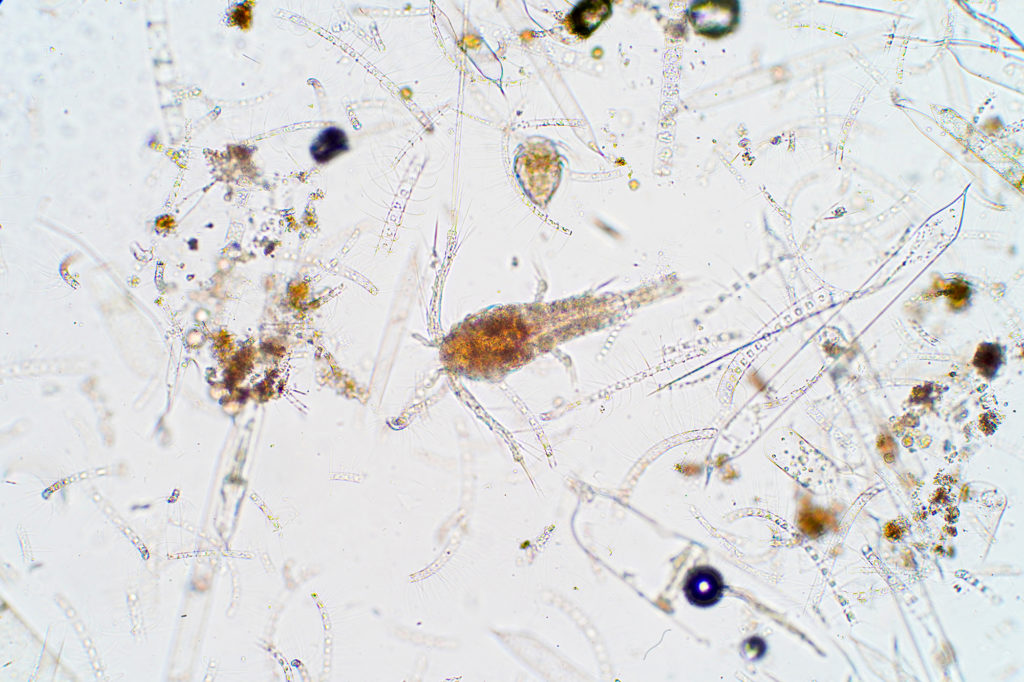


When people are asked to name a marine organism, the list typically includes large animals like whales, seals, or fish.
Most marine organisms are quite small and are carried around by water currents.
Plankton is the term used to refer to groups of organisms too small to swim against water currents.

Even the largest of marine organisms like whales are dependent directly or indirectly on plankton within food webs.
Plankton serve three functional roles: phytoplankton (“plant-like” plankton) are the producers that carry out photosynthesis. Zooplankton (“animal-like” plankton) are the consumers that eat each other and phytoplankton. Bacterioplankton are the decomposers.

Marine Producers
The primary producers of the ocean are microscopic phytoplankton, including protists like algae and diatoms.
Marine Consumers
The majority of marine consumers are zooplankton, including protists and small animals.


Marine Decomposers
Most decomposition is carried out by bacterioplankton, species of bacteria that enable nutrients to cycle back to producers.
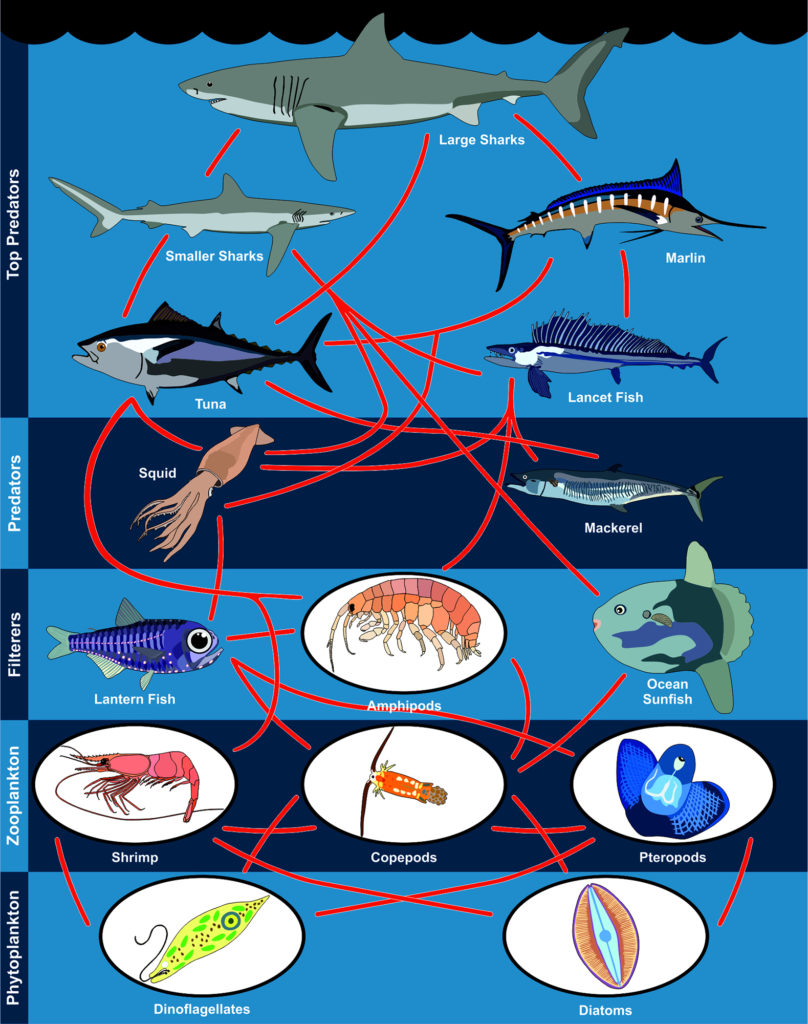
Massive numbers of phytoplankton are needed to support higher trophic (feeding) levels.
Both the food web and food chain images show small shrimp-like crustaceans called krill.
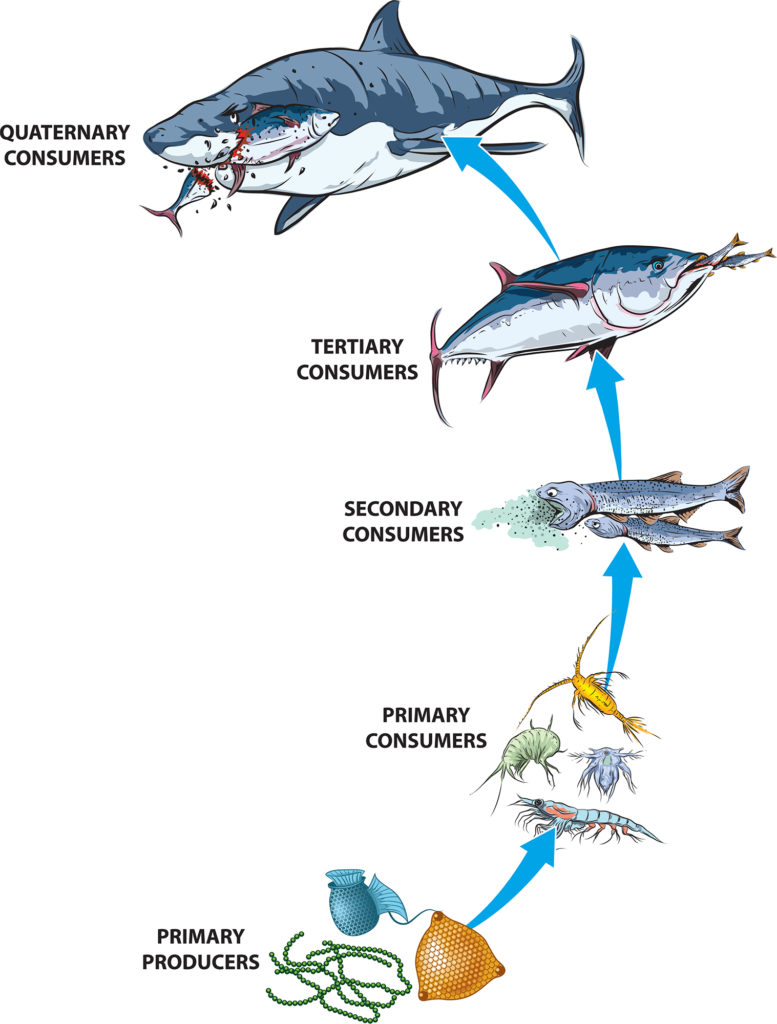

Krill are consumer zooplankton and can exist in enormous numbers, eating phytoplankton and smaller zooplankton.


Many larger consumers like fish, squid, birds, and even marine mammals rely on the massive numbers of krill for survival.
In the next section we will explore how krill are being impacted by changes in phytoplankton food availability.
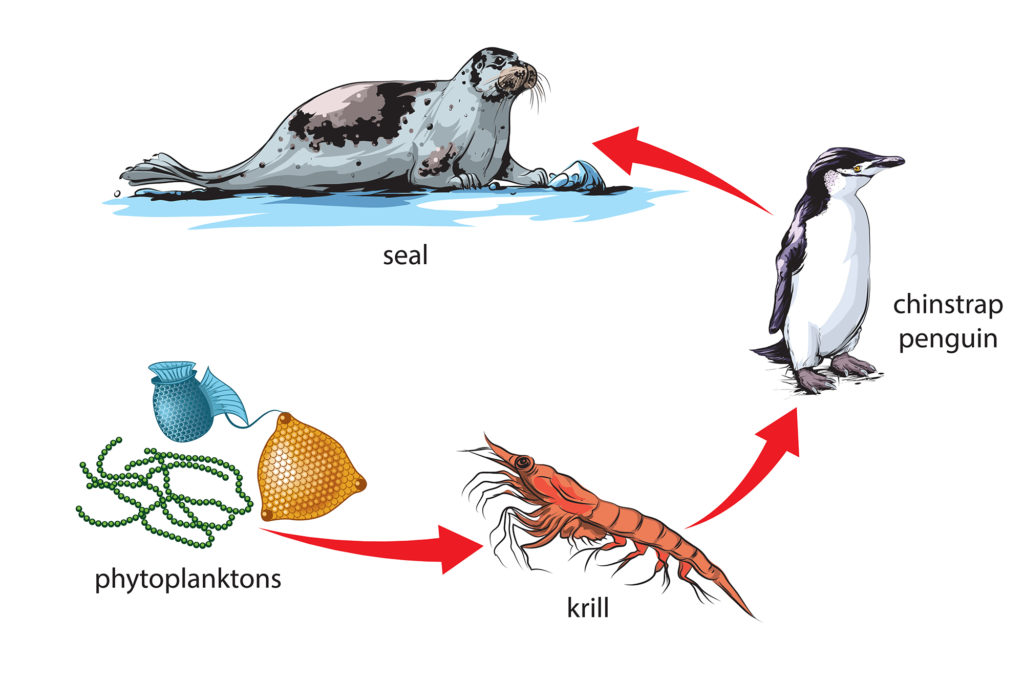
Microscopy reveals the world of plankton. This book contains incredible images of an otherwise hidden world.
Protists

Protists are species taxonomically classified in Domain E____ and Kingdom Protista.

Functionally, most Protists are microscopic aquatic producers or consumers. The decomposer species are the relatively uncommon terrestrial slime molds found in forests.
Most protist producers in saltwater and freshwater are microscopic algae and diatoms. Dinoflagellates in saltwater are associated with “red tides” of toxic chemicals, but some species play an important mutualistic role with coral animals as we will examine in Guide 6B.


Common freshwater consumer protists include paramecia and amoeba. In saltwater there are many consumer species, including Formanifera that look like tiny snail shells, but are not animals.

The protist that most people are familiar with is algae. Algae is found everywhere there is moisture. If you leave a glass of water out in most parts of the world, algal spores moving in the air will land in the water and produce a visible colony in a week or so. Algae sometimes lives inside of other organisms, like the algae in lichen fungi.
We were at the coast taking videos and photos for this module, and found a slimy coating of algae on a sidewalk. Can’t pass this up!


Diatom species are similar to algae in that they also photosynthesize, but they differ in having a silicon structure that persists long after they are dead.

Macroalgae
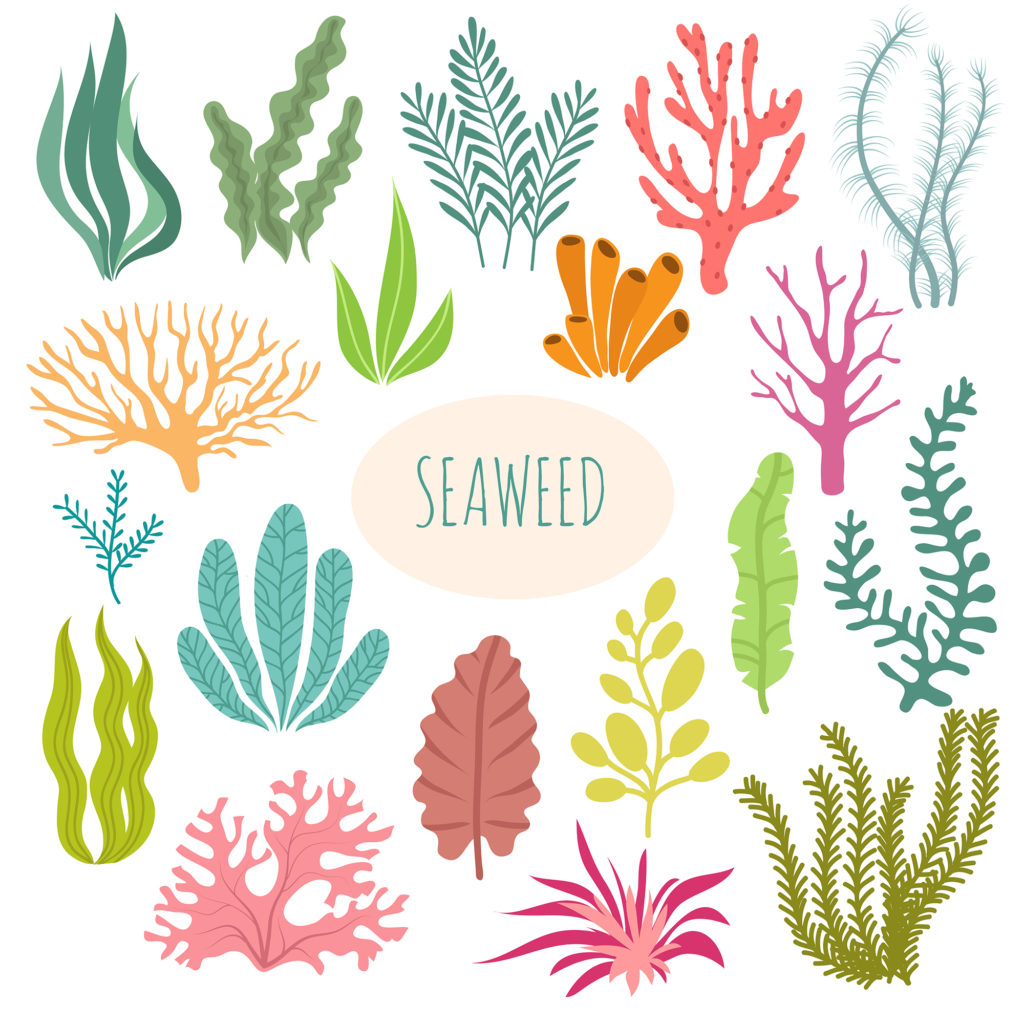
Most marine producers are tiny, but there several notable macro(large) producers including the seaweeds.
Seaweeds are not plants, they are actually large algae. You can tell by squishing fresh seaweed between your fingers: it squishes easily unlike the more structured plants.
Kelp, algae and diatoms are all classified in Domain Eukaryota and Kingdom _____.
If you have searched the beach after a storm, you have probably seen many of the macroscopic producers washed ashore.
Kelp is algae (seaweed) that grows along many coastlines and appears like an underwater forest.
These sea otters have wrapped emerging kelp around their bodies to stay in place as they sleep.
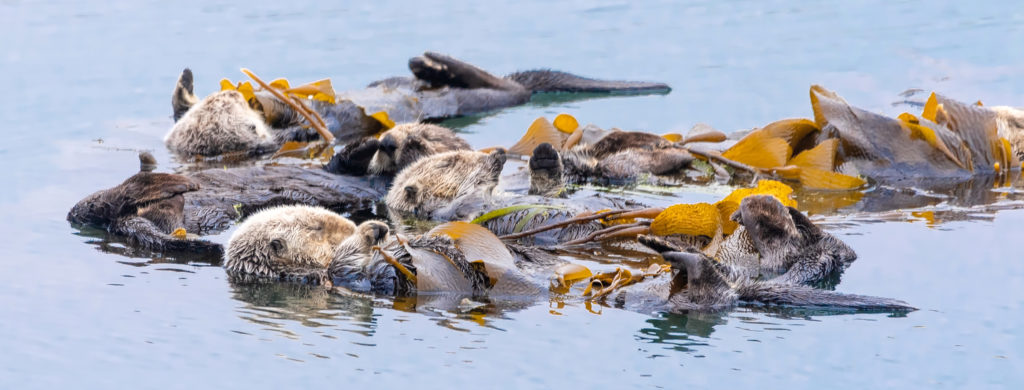
This video introduces the three basic types of macroalgae, also called kelp or seaweed.


We can see macroalgae and a bit of sea grass in this beach debris sample.
Kelp may not have the vascular system or tissue complexity of plants, but they can still be huge. This kelp measured well over 5 meters (15 feet) in length.
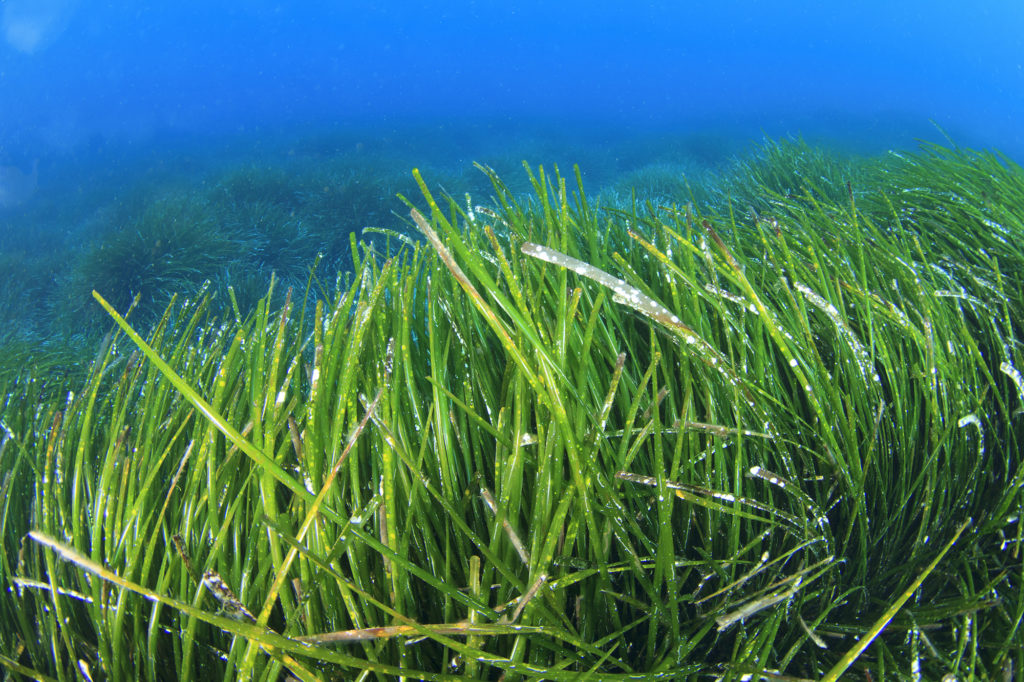
There are some marine plants like this sea grass, but sea plants are primarily found around coastlines. Marine plants are nowhere near as abundant as algae, diatoms, dinoflagellates, bacteria and archaea producers.
Before we head to various ocean zones in this guide and the next, a word on safety specific to coastal adventures.
The next section introduces ocean zones and how they relate to marine life.

Check your knowledge. Can you:
- Provide examples of marine plankton and their roles in food webs?
- List examples of producer and consumer Protists?
- Describe the types of macroscopic producers found in marine habitats?



